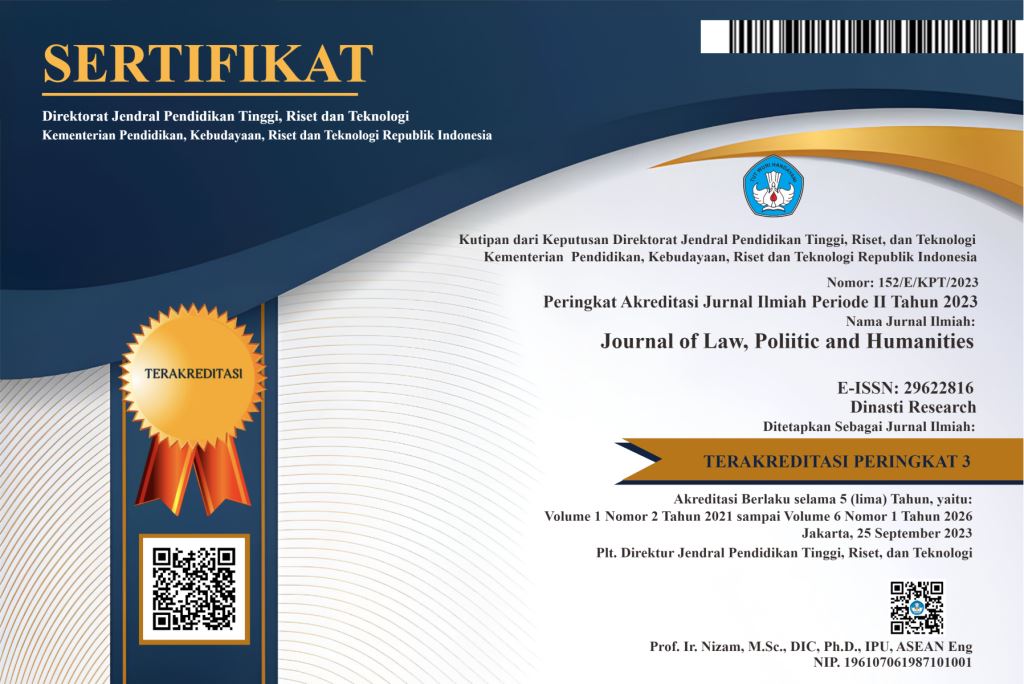Implementation of Article 7 of Undang-Undang No. 1 of 1974 and Article 7 of Undang-Undang No. 16 of 2019 concerning the Minimum Age Limit for Marriage in Suppressing Cases of Early Marriage
DOI:
https://doi.org/10.38035/jlph.v5i6.2287Keywords:
Marriage Age Limit, Marriage Dispensation, Article 7, Marriage Law, Early Marriage, Sukabumi CityAbstract
This study aims to examine the implementation of Article 7 of Undang-Undang No. 1 of 1974 and Article 7 of Undang-Undang No. 16 of 2019 concerning the minimum age of marriage in suppressing cases of early marriage, especially in the Sukabumi City area. Although there has been a change in the minimum age from 16 years to 19 years for women, the phenomenon of child marriage still continues to take advantage of the gap in marriage dispensation from the courts. Through an empirical juridical approach and supported by field data and interviews with judicial officials, this study shows that the high number of marriage dispensation applications after the change in the law indicates that the law is still weak in practice. Social, cultural, and lack of legal education are also the main causes of the high dispensation of child marriage. Therefore, a more progressive legal approach and the active participation of all parties are needed to strengthen child protection and suppress the practice of early marriage across the board.
References
Bambang Waluyo. Penegakan Hukum di Indonesia. Jakarta: Sinar Grafika, 2011.
Direktori Putusan Mahkamah Agung. Diakses 8 Februari 2025 pukul 20.40. https://putusan3.mahkamahagung.go.id/.
Gumilang, Nanda Akbar. “Pengertian Wawancara: Jenis, Teknik, dan Fungsinya.” Gramedia. Diakses 16 Februari 2025. https://www.gramedia.com/literasi/wawancara/.
Habibah Nurul Umah. “Fenomena Pernikahan Dini di Indonesia Perspektif Hukum Keluarga Islam.” Jurnal Al Wasith 5 (2020): 4.
Kompilasi Hukum Islam: Bab II Tentang Dasar-Dasar Perkawinan. Jakarta: Kementerian Agama RI.
M. Syarfi Iqbal dan Moh. Asyiq Amarulloh. “Pembatasan Usia Minimal Perkawinan dalam Hukum Keluarga Islam: Studi Komparasi Indonesia dan Yordania.” As-Syar’i 6 (2024): 1239.
Muhaimin. Metode Penelitian Hukum. Mataram: Mataram University Press, 2020.
Qotrun A. “Apa Itu Observasi? Berikut Pengertian, Ciri, Tujuan, dan Jenisnya.” Gramedia. Diakses 16 Februari 2025. https://www.gramedia.com/literasi/apa-itu-observasi/.
Rahmat Karyadi. “Hukum Perkawinan Menurut Undang Undang No 16 Tahun 2019.” Journal Pusat Studi Pendidikan Rakyat 2 (2022): 12.
Satjipto Rahardjo. Hukum dan Perubahan Sosial. Yogyakarta: Genta Publishing, 2009.
———. Hukum Progresif: Hukum yang Membebaskan. Jakarta: Kompas, 2009.
———. Ilmu Hukum. Bandung: Citra Aditya Bakti, 2006.
———. Membedah Hukum Progresif. Jakarta: PT. Kompas Media Nusantara, 2006.
Syarifah Lisa Andrianti, Mutiara Sari, dan Windha Wulandari. “Implementasi Perubahan Batas Usia Perkawinan.” Binamulia Hukum 11 (2022): 2.
Undang-Undang No. 16 Tahun 2019 tentang Perubahan atas Undang-Undang No. 1 Tahun 1974 tentang Perkawinan.
Undang-Undang No. 23 Tahun 2004 tentang Penghapusan Kekerasan dalam Rumah Tangga.
Undang-Undang No. 35 Tahun 2014 tentang Perubahan atas Undang-Undang No. 23 Tahun 2002 tentang Perlindungan Anak.
Downloads
Published
How to Cite
Issue
Section
License
Copyright (c) 2025 Arsista Augusty, Prahasti Suyaman

This work is licensed under a Creative Commons Attribution 4.0 International License.
Authors who publish their manuscripts in this journal agree to the following conditions:
- The copyright on each article belongs to the author(s).
- The author acknowledges that the Journal of Law, Poliitic and Humanities (JLPH) has the right to be the first to publish with a Creative Commons Attribution 4.0 International license (Attribution 4.0 International (CC BY 4.0).
- Authors can submit articles separately, arrange for the non-exclusive distribution of manuscripts that have been published in this journal into other versions (e.g., sent to the author's institutional repository, publication into books, etc.), by acknowledging that the manuscript has been published for the first time in the Journal of Law, Poliitic and Humanities (JLPH).


























